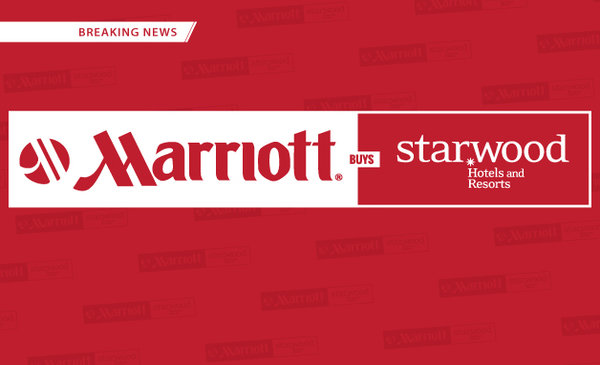
A few months back, when Marriott International was given government approval to acquire Starwood Hotels and Resorts Worldwide, there was no question that this was the biggest deal in the history of the modern hotel business.
Aside from the $13bn price tag, the acquisition turned Marriott into the largest hotel group in the world overnight with more than 1 million rooms worldwide. One in every 15 hotel rooms is now Marriott-operated.
When a clearly delighted Arne Sorenson announced the deal in September, the CEO of Marriott International was quick to highlight the scale and range of the new group that he would lead. “We have got an ability to offer just that much more choice. A choice in locations, a choice in the kind of hotel, a choice in the amount a customer needs to spend,” he told The Associated Press on launch day.
Sorenson was not making an idle boast. The deal means that Marriott operates 30 hotel brands around the world. And these aren’t niche hotel brands you have never heard of. The portfolio includes Sheraton, Westin, The Ritz Carlton, W Hotels and Marriott to name but five.
Not so long ago, owning and operating a large portfolio of brands made sense. The bigger the better. But with globalization and the ever-increasing cost of building and protecting brand equity, the fascination with adding more brands has been reversed in recent years. These days it’s the challenge of learning how to kill a brand and keep a customer, as the famous Harvard Business Review article puts it, that occupies most senior managers.
Compare the brand portfolio of any major organization today with how it looked a decade ago and, almost without exception, you will see a leaner and less diversified list of brands than was once the case. Everyone from P&G and Coca-Cola to Ford has moved away from multiple brands and sub-brands towards a simpler, more parsimonious brand architecture in which the number of brands is as tight as strategically possible.
The theory of brand killing could not be more simple. If you want more profit, more focus and stronger brands, you get rid of the weaker ones that compete with your other, stronger offers. Rather than simply kill a few weak and pointless brands on the periphery of the portfolio, the optimum way to approach brand consolidation is to assume you obviously need one brand and then try to make a very good case for having need of a second.
Such is the strategic power of a single branded house that many organizations would be significantly better off sacrificing the versatility and range of multiple brands for the dead-eyed focus and operational efficiencies of a single branded offer.
That logic is all well and good for guys like me who are legends in their own lecture hall. But try making the case to Marriott that it clearly needs the corporate brand but doesn’t need any of the other brands in the portfolio. We’re talking hundreds of millions in financial brand equity, customer affection, brand heritage and loyalty programs. The idea of killing a couple of the portfolio of brands that Marriott now owns is a daunting prospect despite the fact that there are clear overlaps in the newly merged portfolio.
The person facing this unenviable challenge is chief brand officer Tina Edmundson. She will have to work out how many brands Marriott actually needs and then how to silently kill the unwanted options and ensure customers are efficiently passed to one of Marriott’s surviving offers.
So far, Marriott, perhaps understandably, has moved slowly and not entirely impressively. Its new corporate website, for example, divides up the hotel portfolio into different categories, including classic luxury (Ritz Carlton or St Regis), distinctive luxury (W Hotels), classic premium (Marriott or Sheraton) and distinctive premium (Westin or Le Meridien). I’m not sure what purpose these arbitrary groupings play but like most category thinking it will mostly serve to get in the way of seeing how customers select hotels.
Categories do not actually exist and they usually blind us to the real structure of customer thinking and competitors – competitors that invariably attack us from outside the category we spent 18 months inventing and outside the rival brands we mistakenly assumed we were up against. One of the main reasons Marriott and Starwood committed to the deal is the stellar growth of Airbnb – a brand that is happily taking a lion’s share of the hotel market without ever considering itself to be a hotel.
It’s early days and you can be sure that Edmundson is, as we speak, scouring perceptual maps and segmentation charts to ascertain which brands she will kill and which she will keep. It’s certainly one of the biggest jobs in branding right now and also one of the most daunting. Irrespective of where she plans to stay in the months ahead, Tina Edmundson should not plan on getting much sleep.
This thought piece is featured courtesy of Marketing Week, the United Kingdom’s leading marketing publication.
Meet the requirements for Brand Leadership in the Age of Disruption. Join us in Hollywood, California for our 5th annual competitive-learning event designed around brand strategy.
The Blake Project Can Help: The Brand Architecture Workshop
Branding Strategy Insider is a service of The Blake Project: A strategic brand consultancy specializing in Brand Research, Brand Strategy, Brand Licensing and Brand Education
FREE Publications And Resources For Marketers











